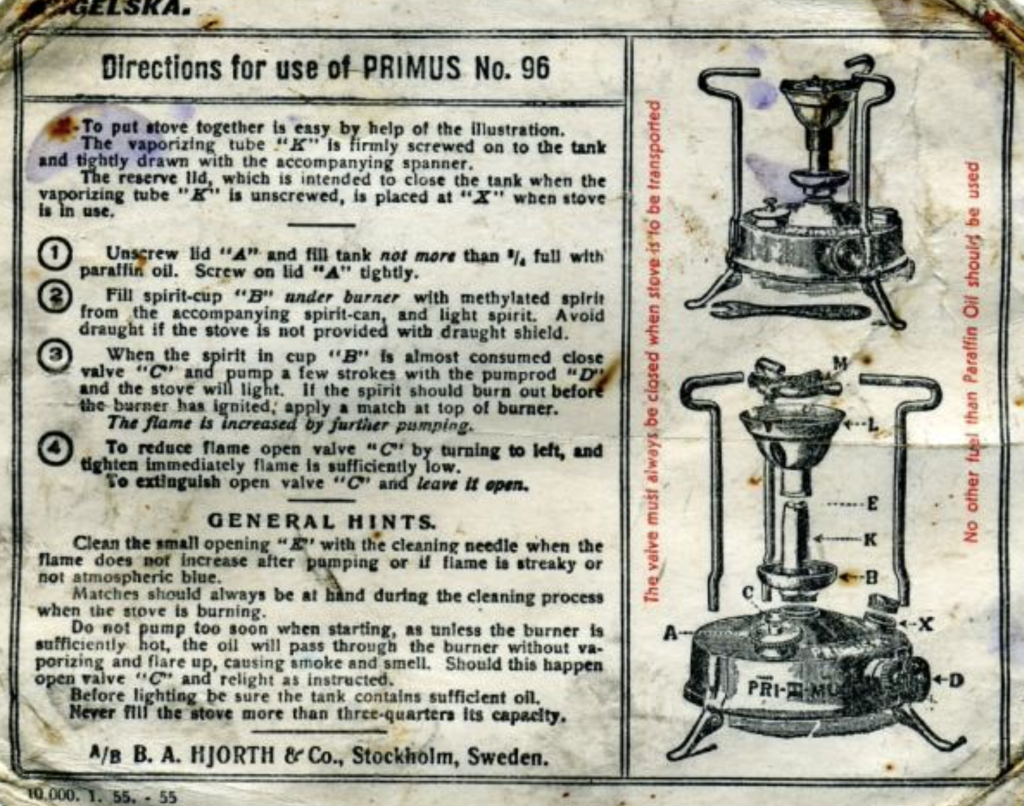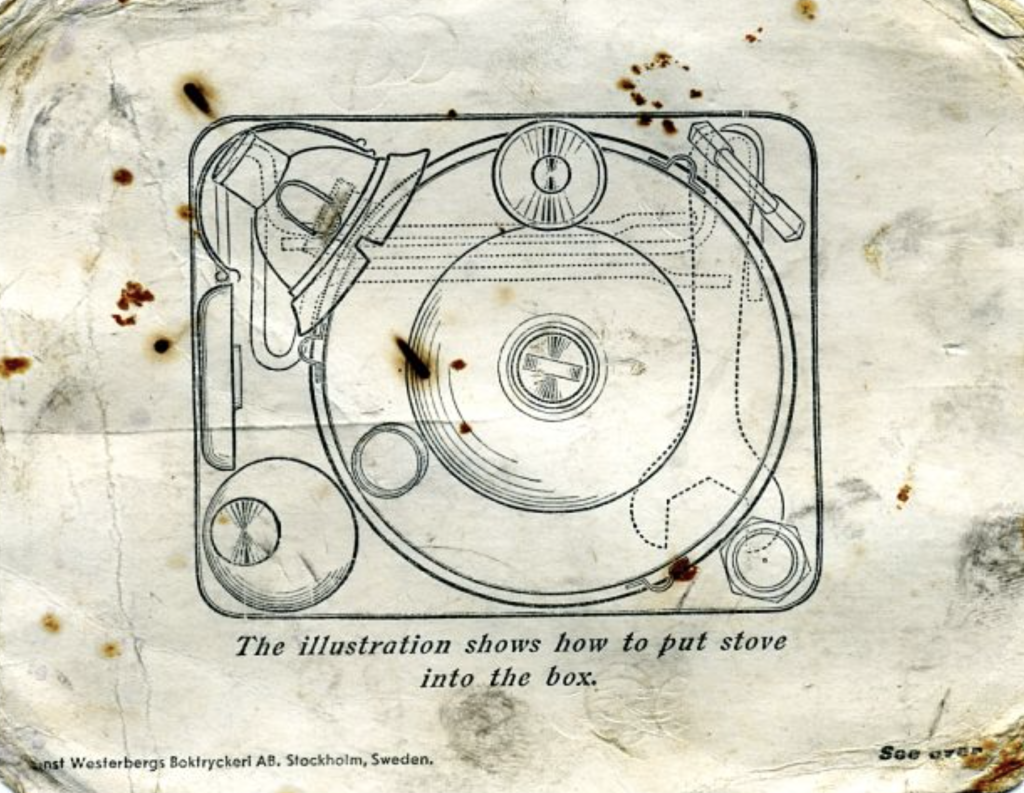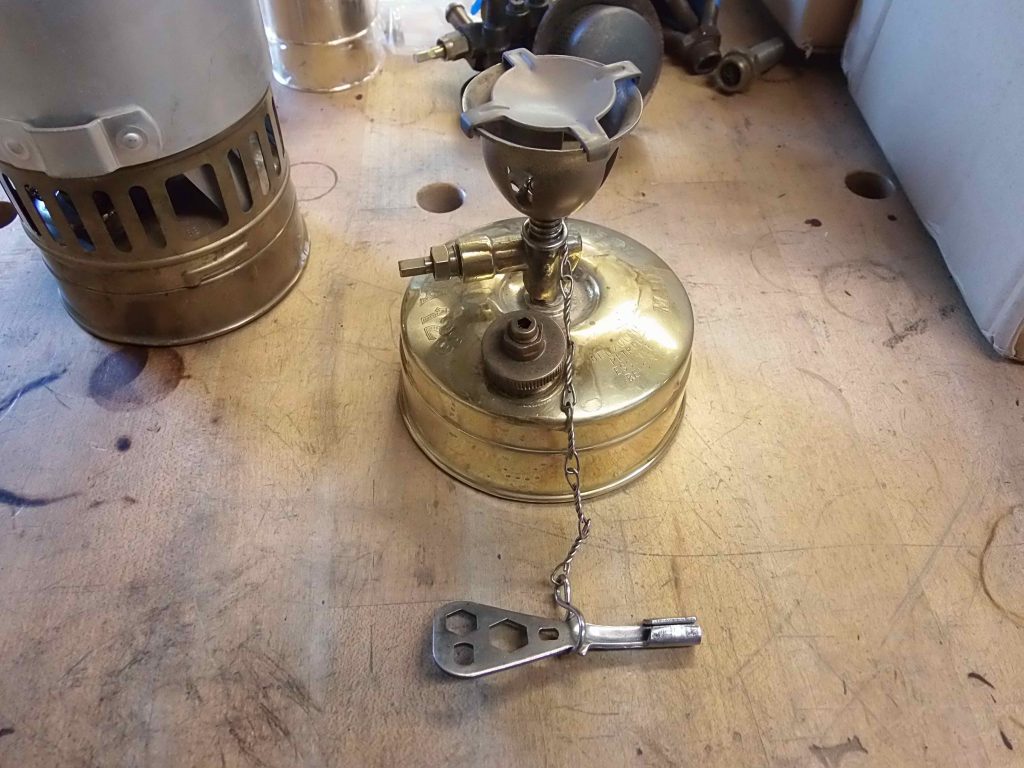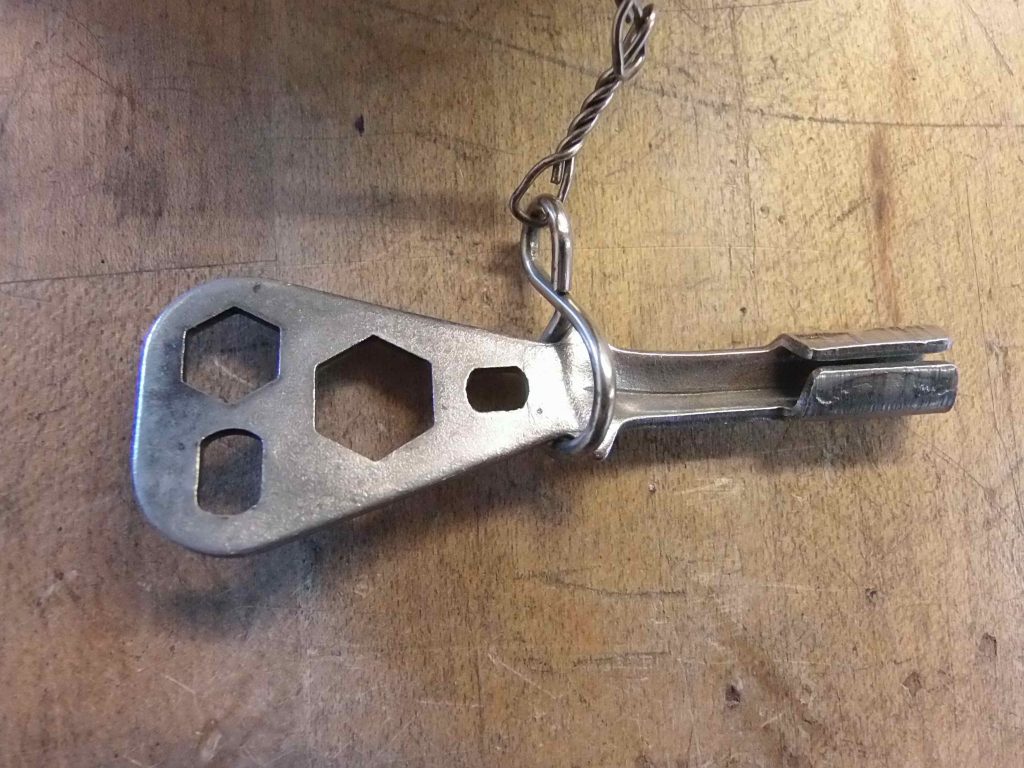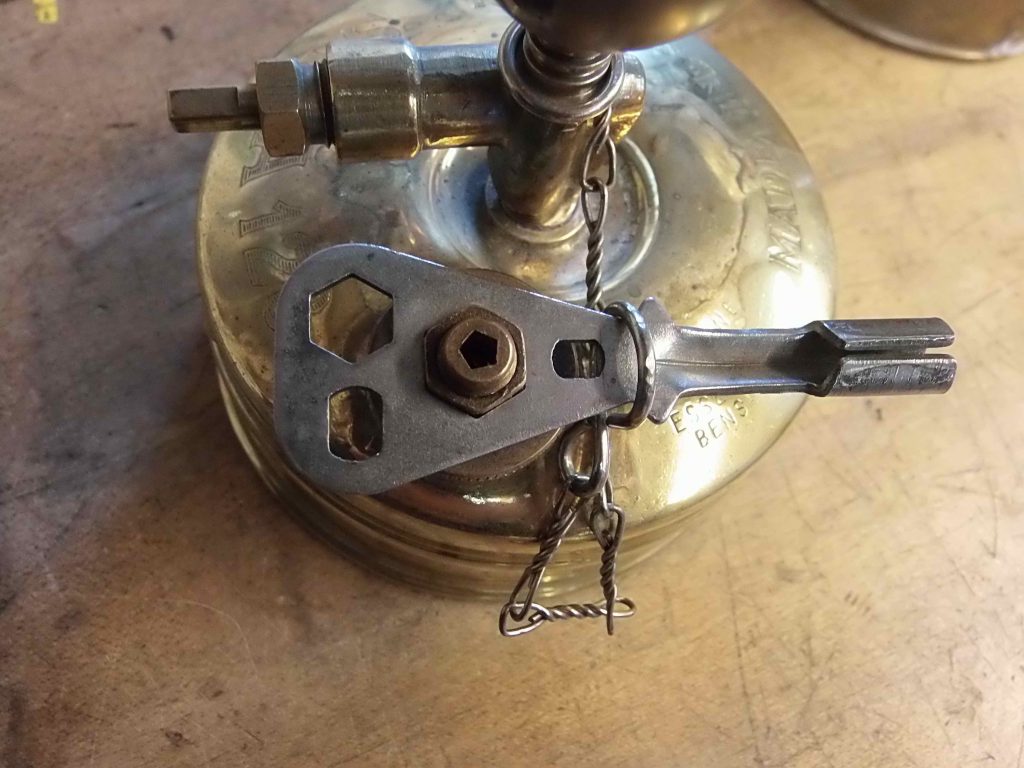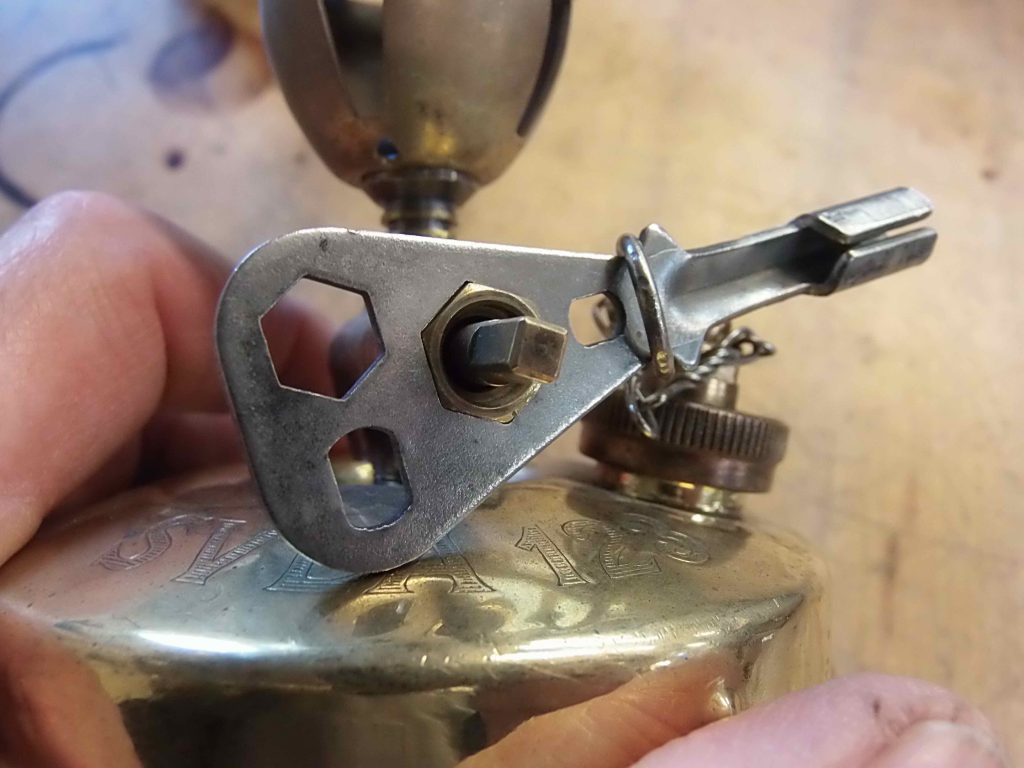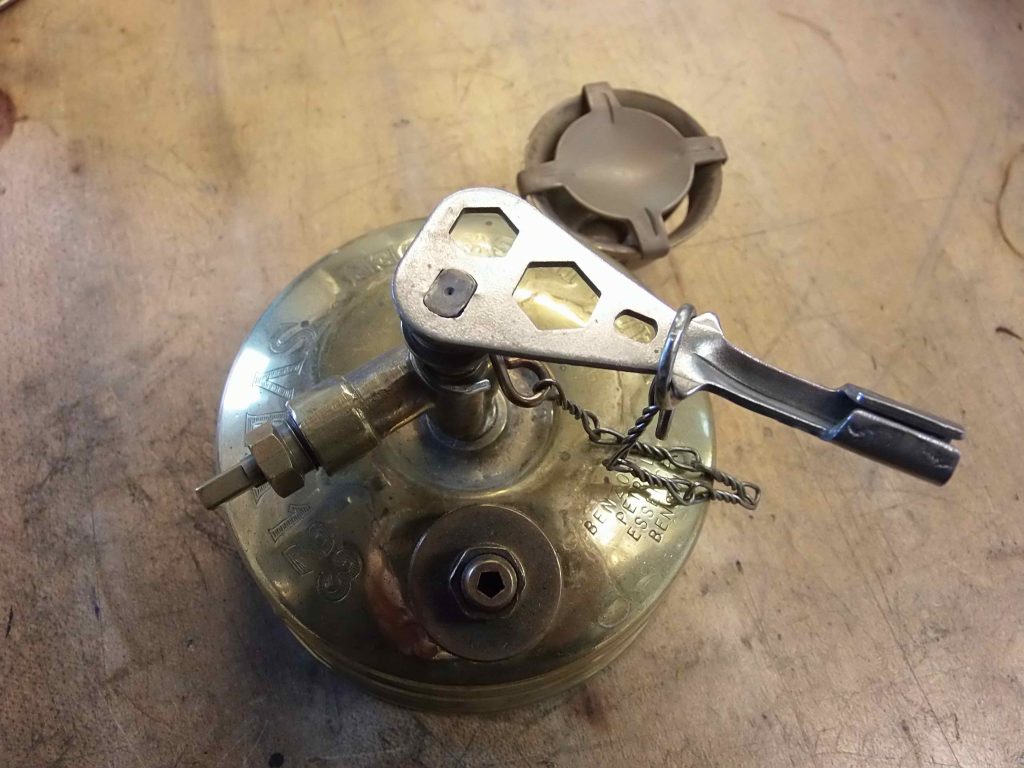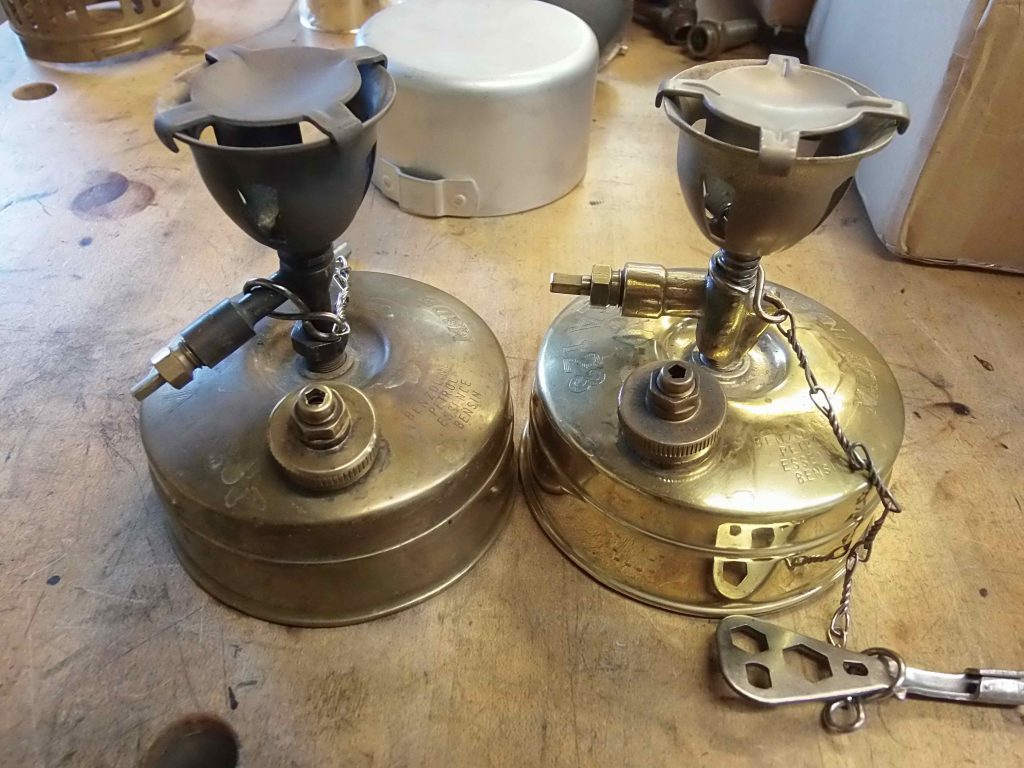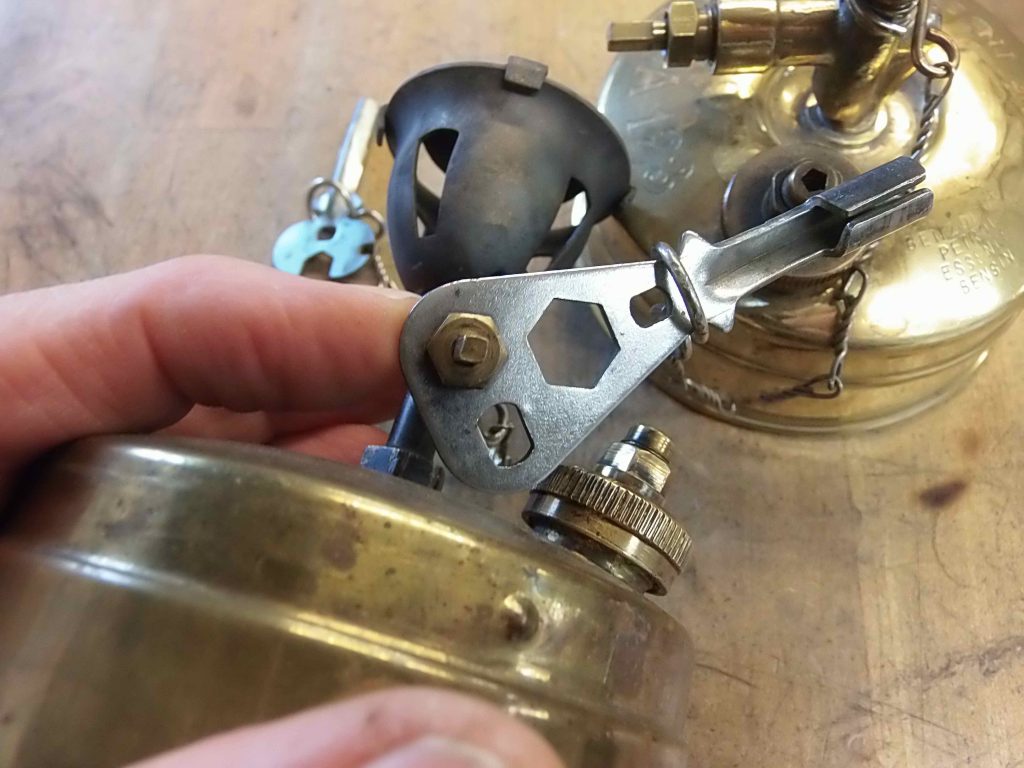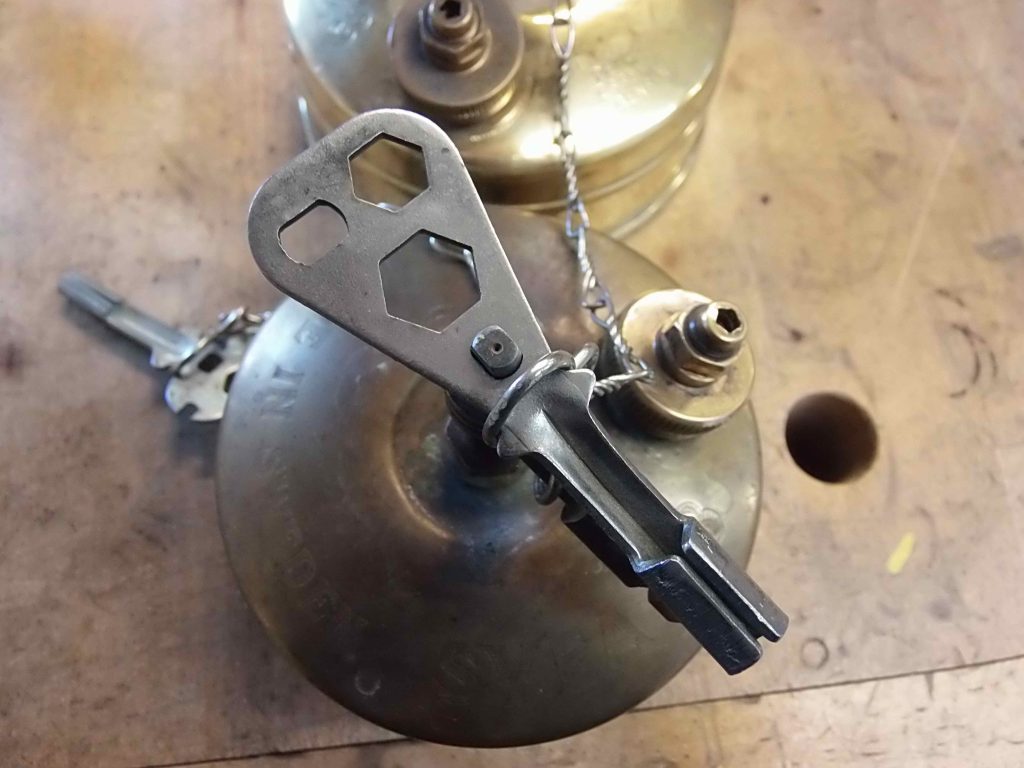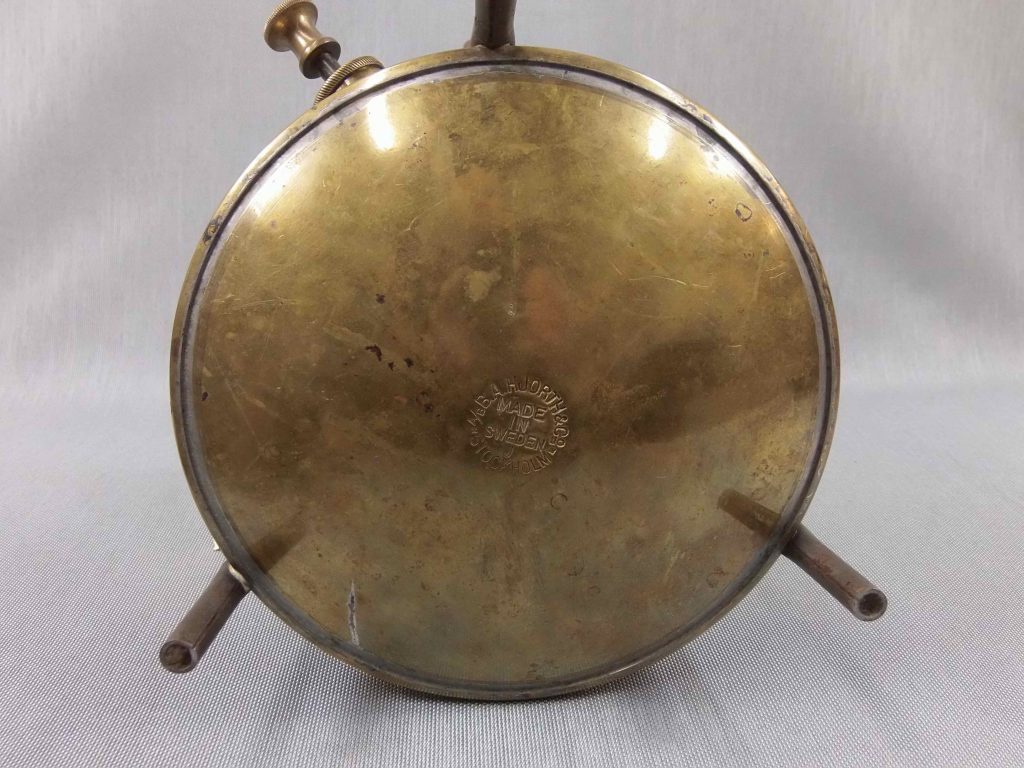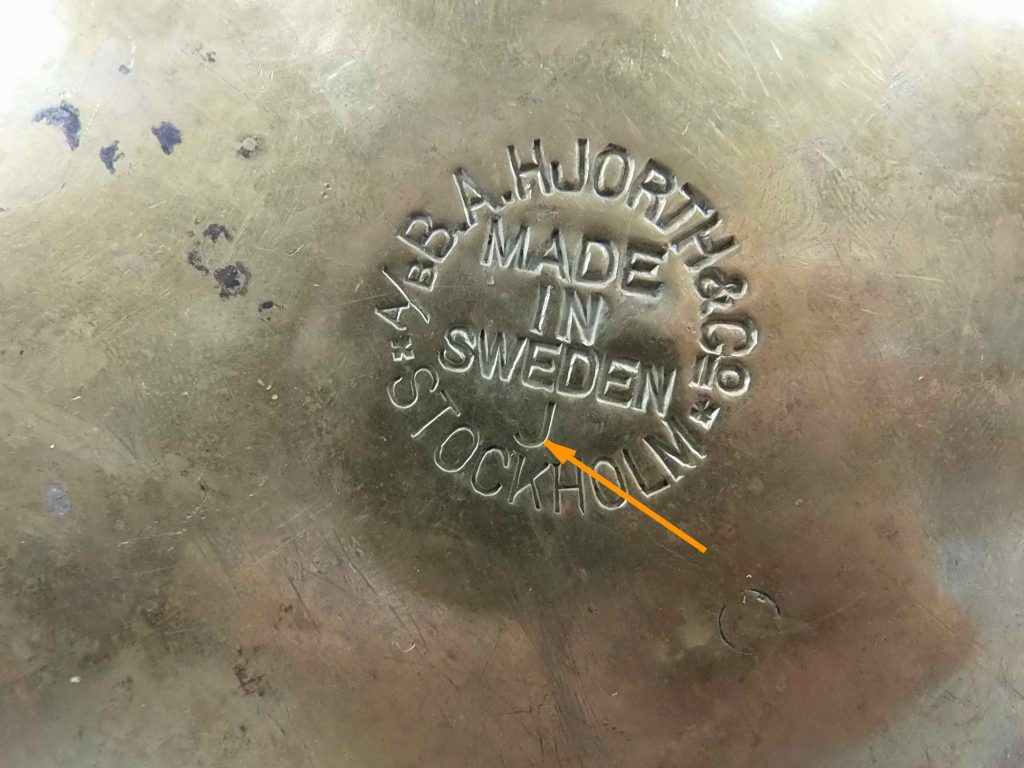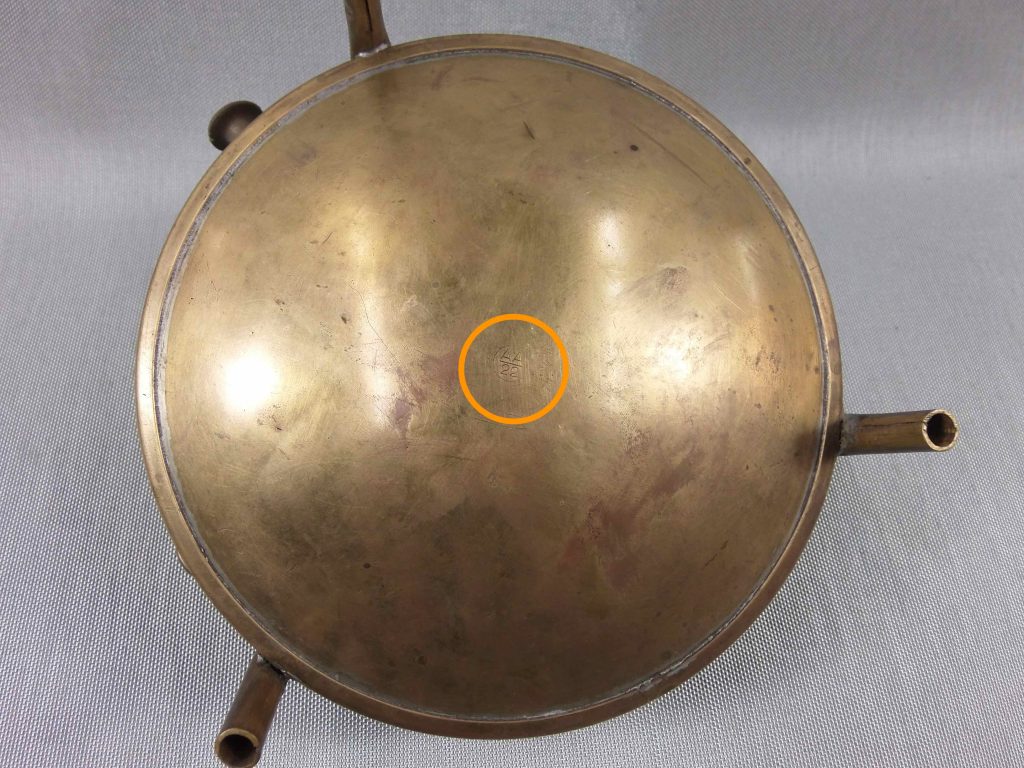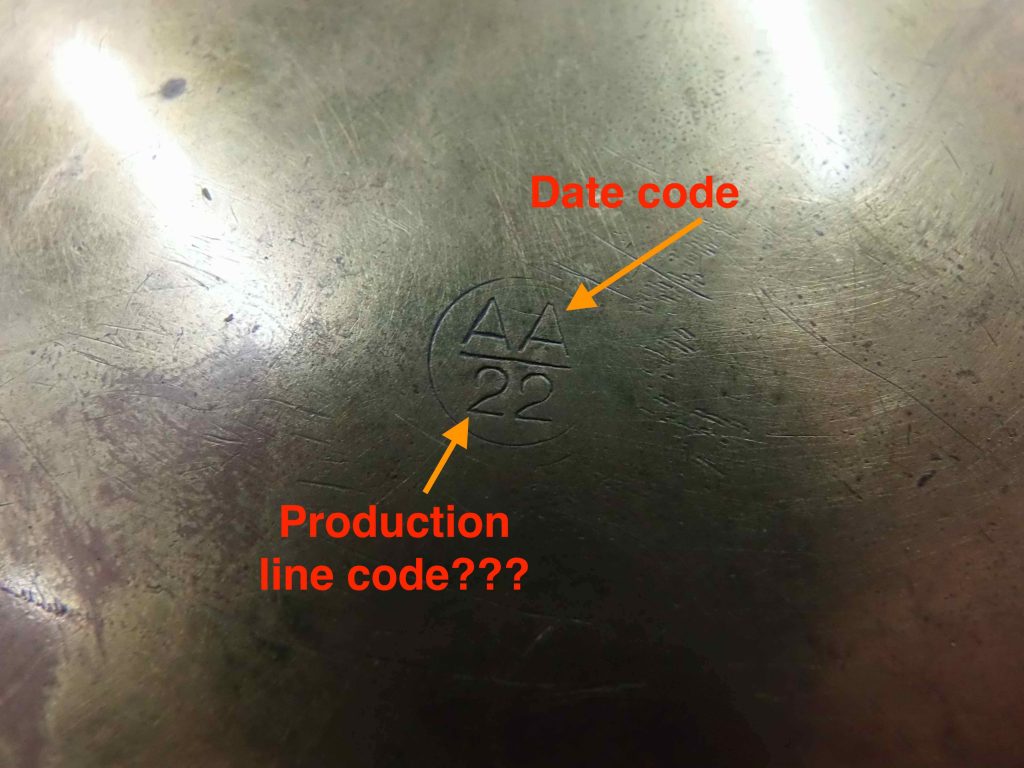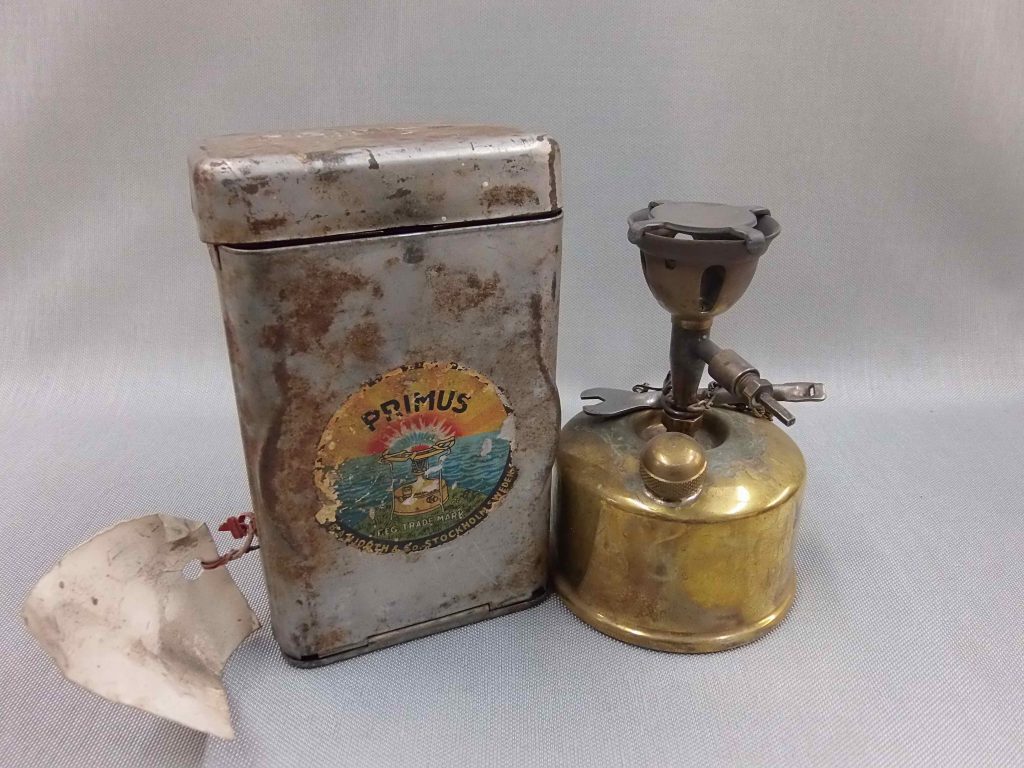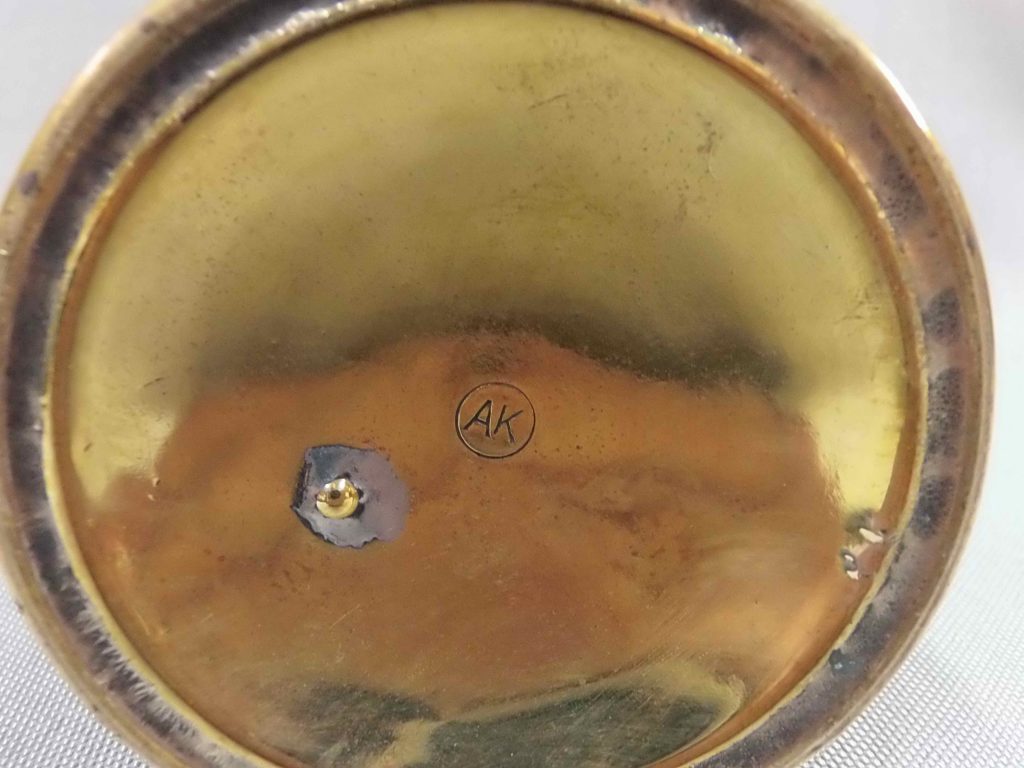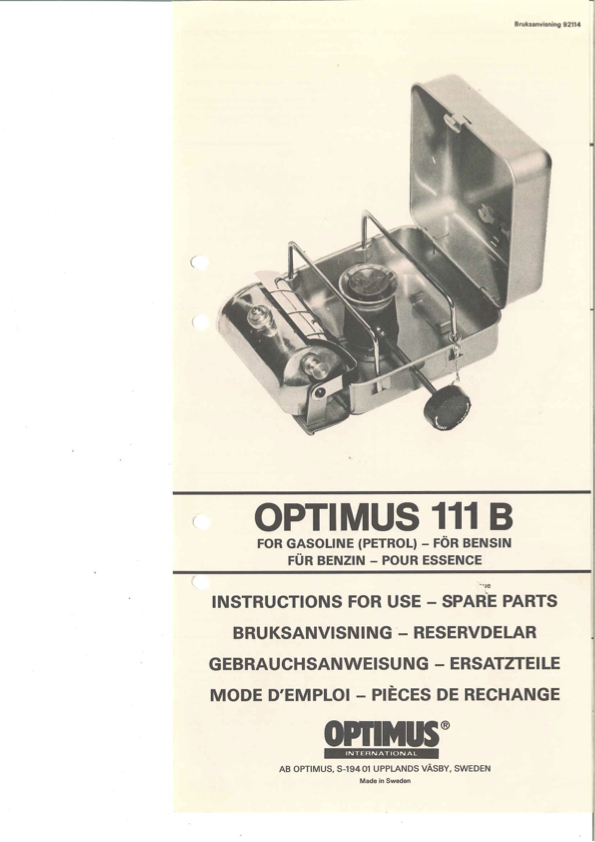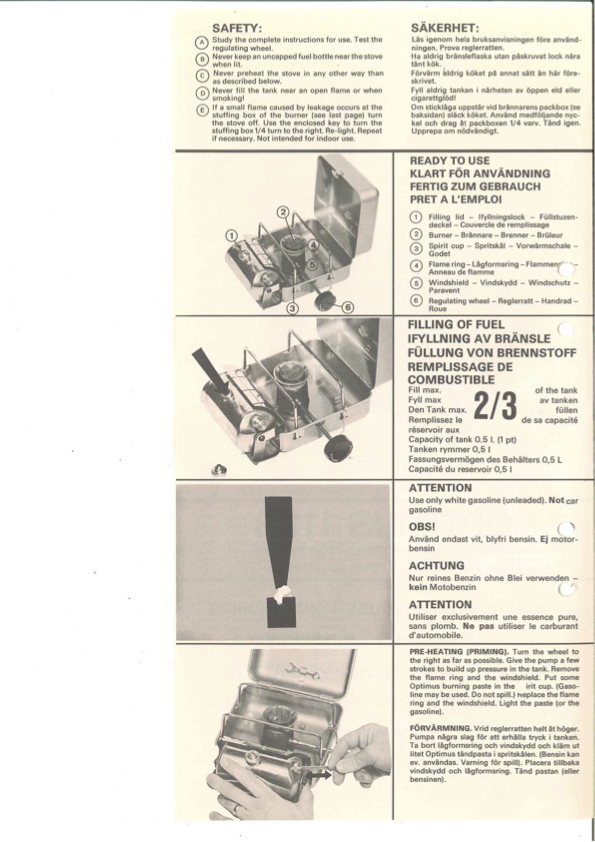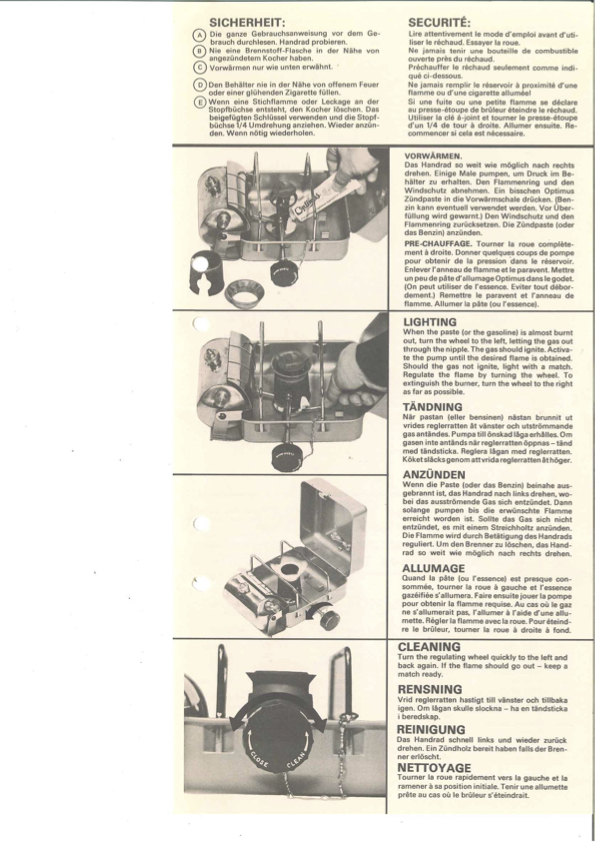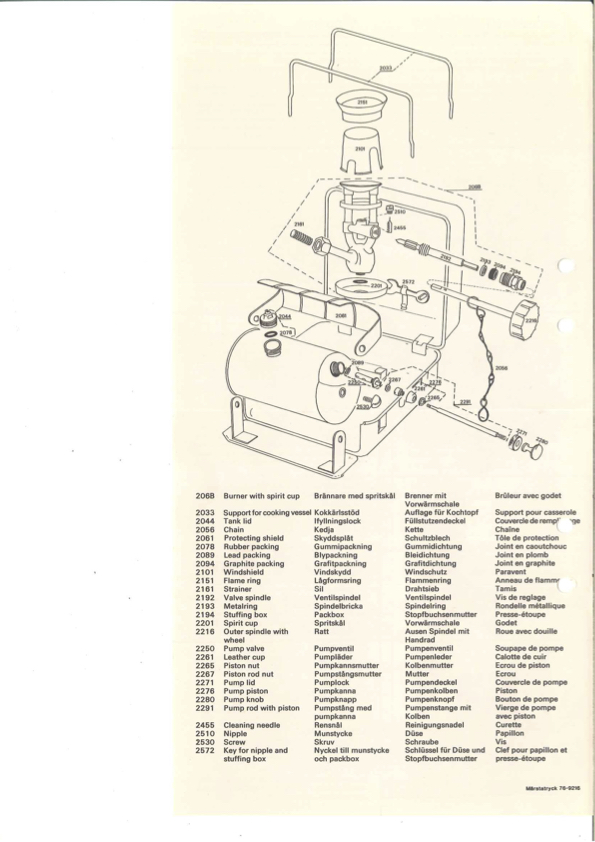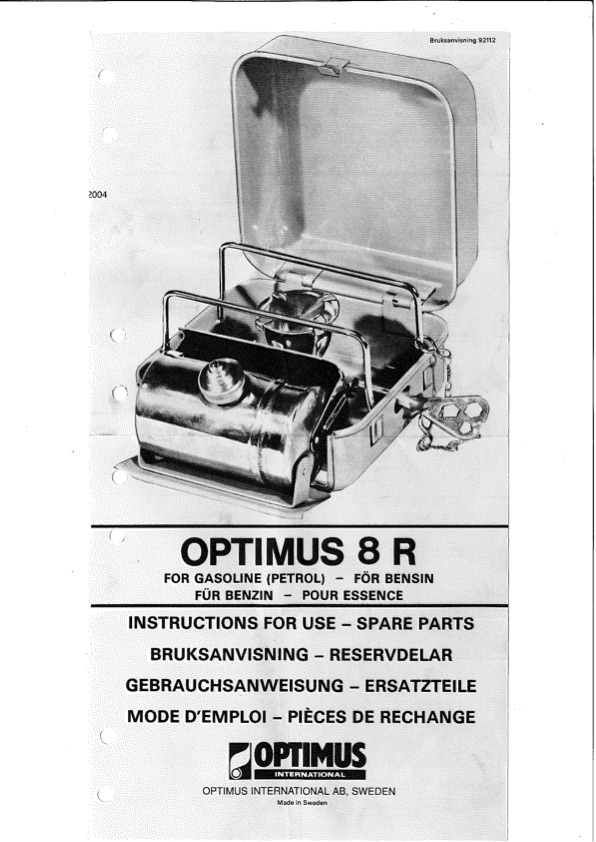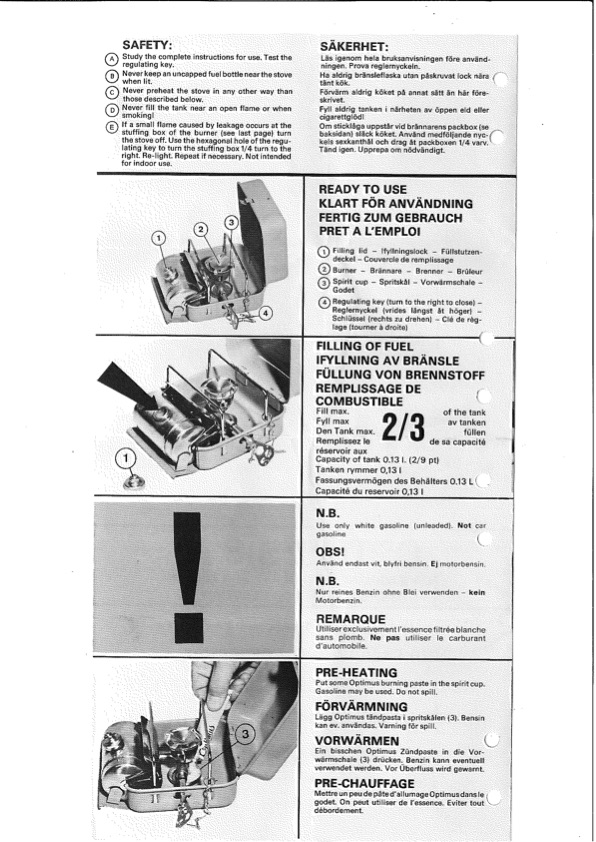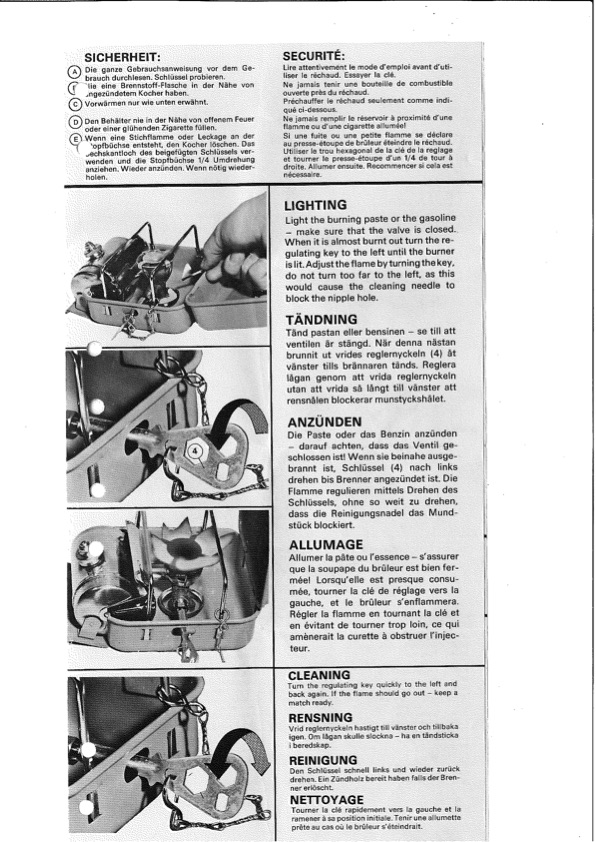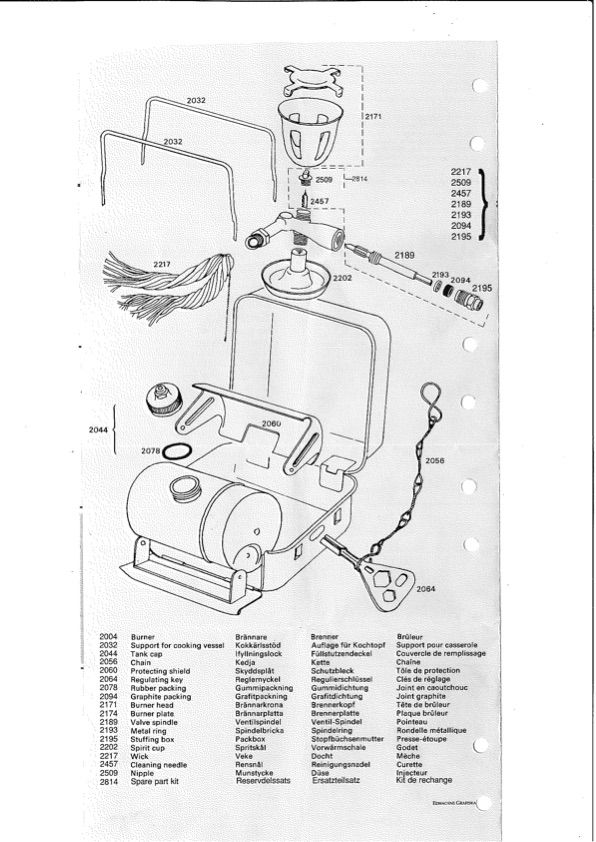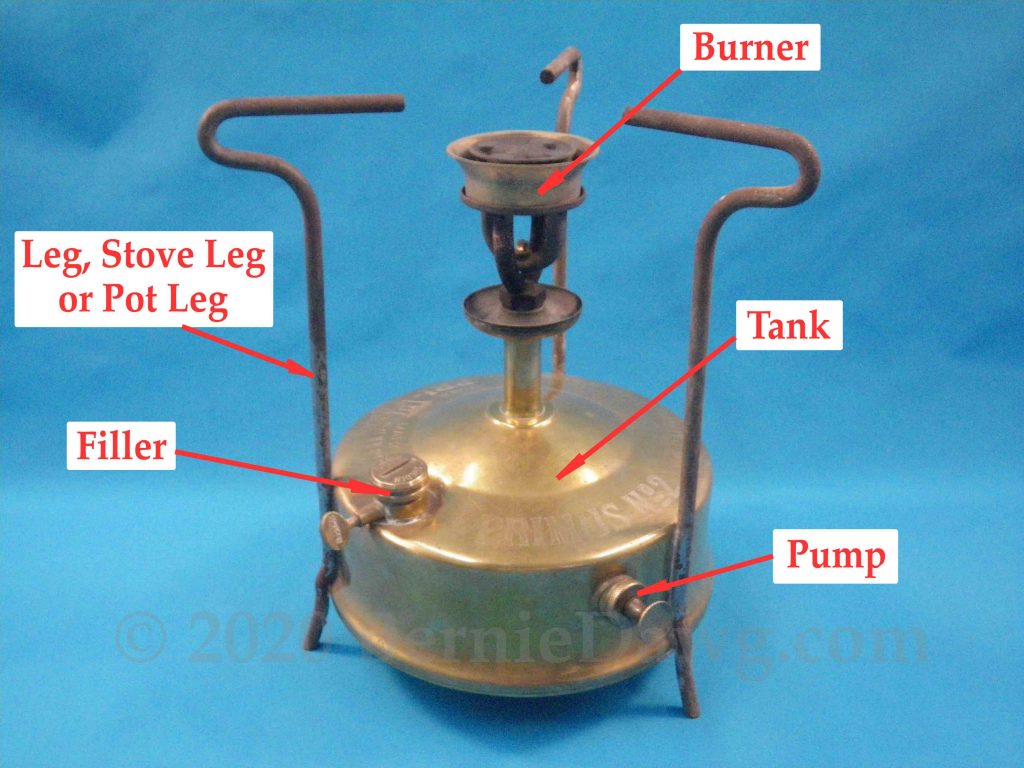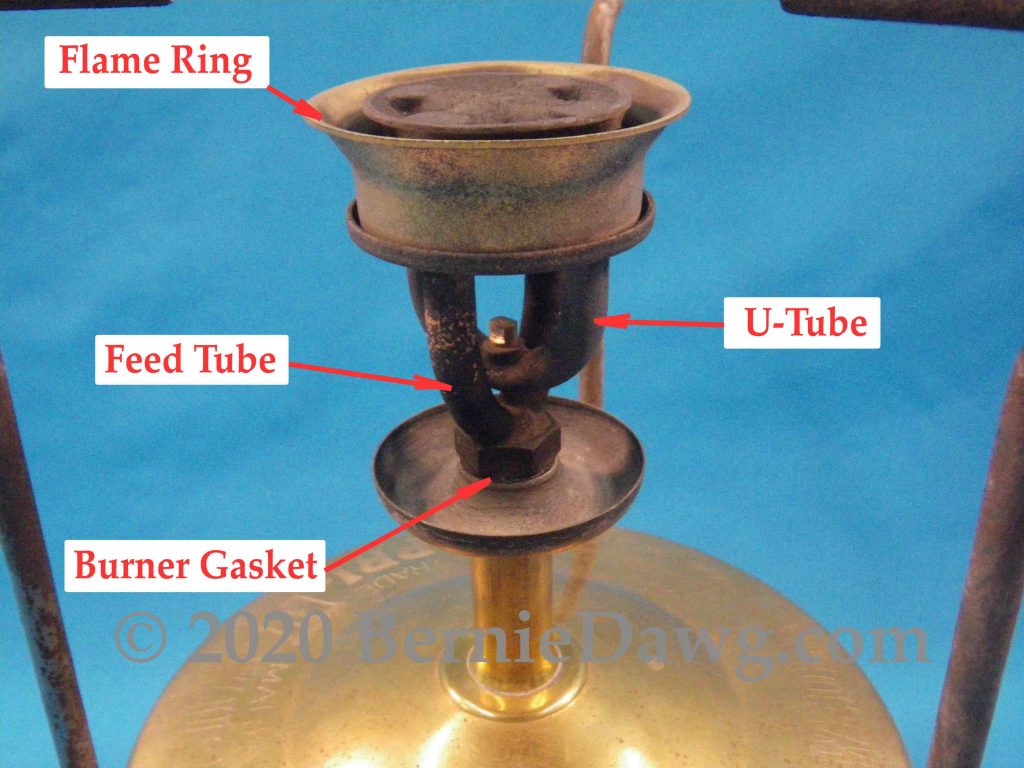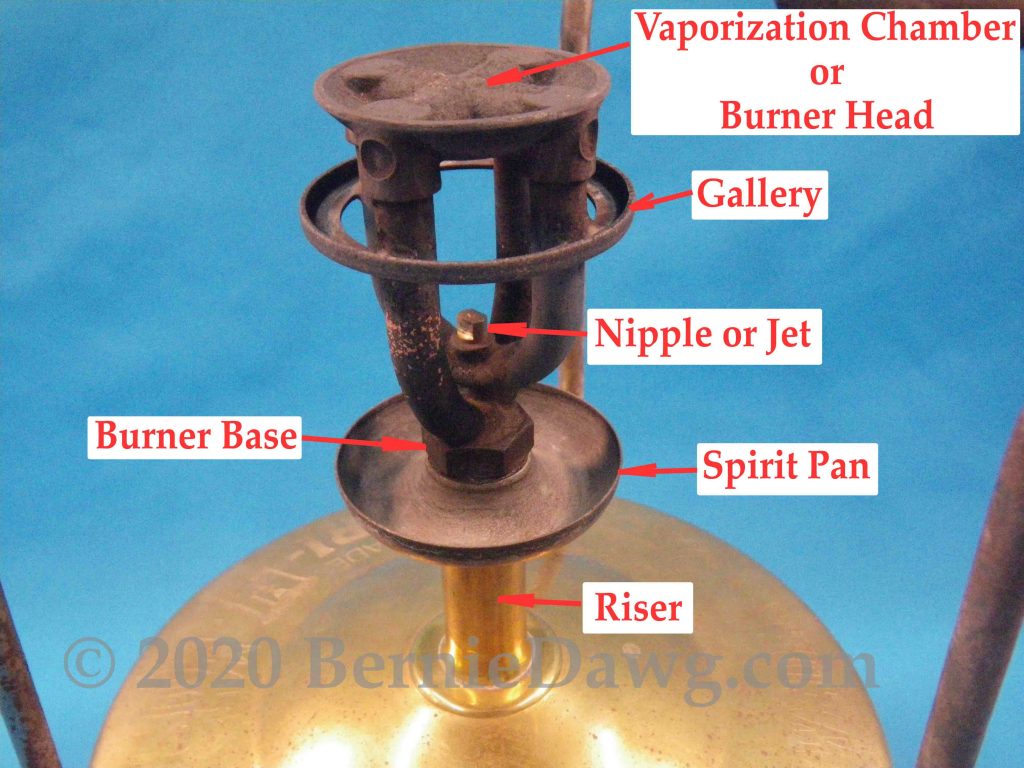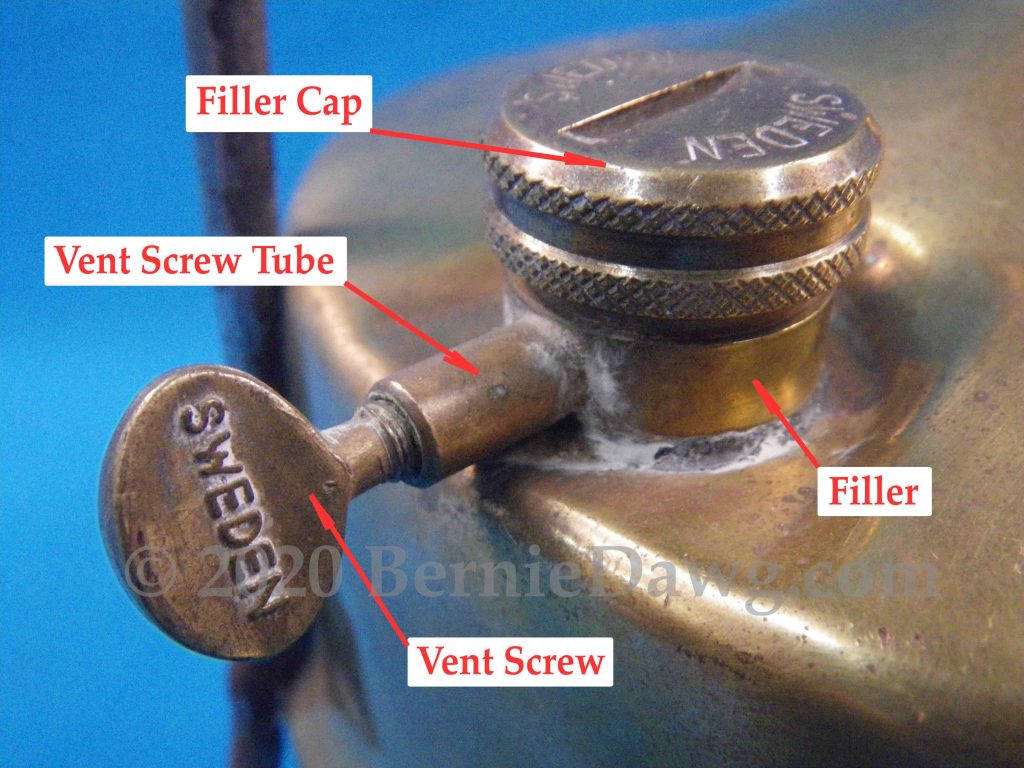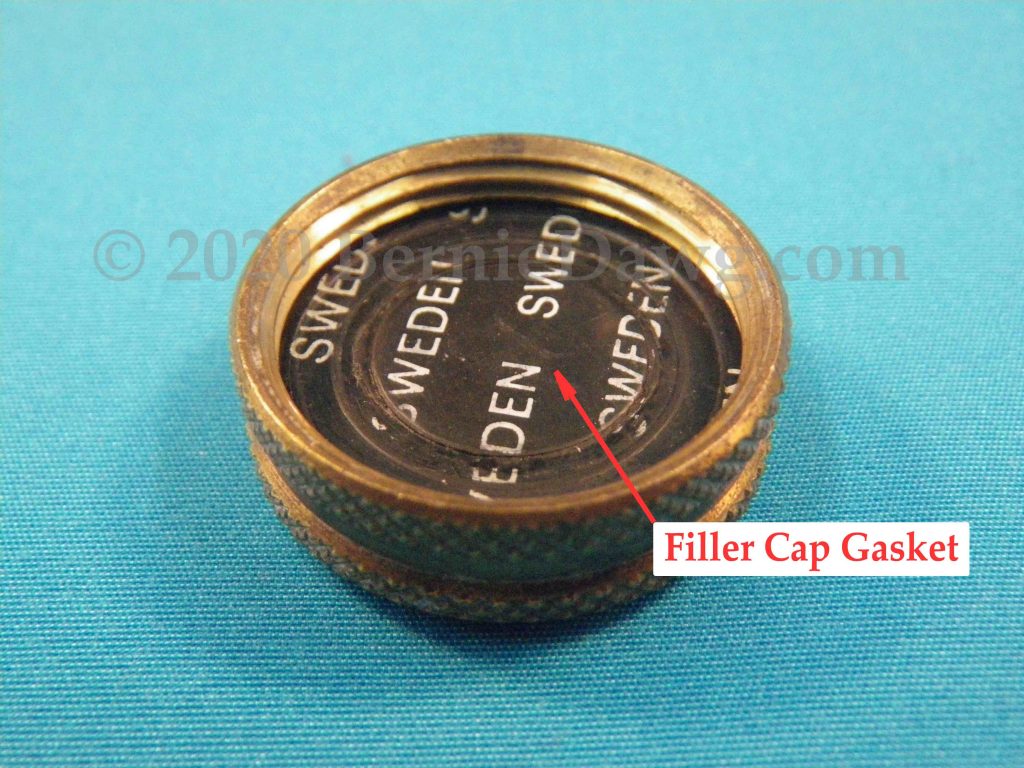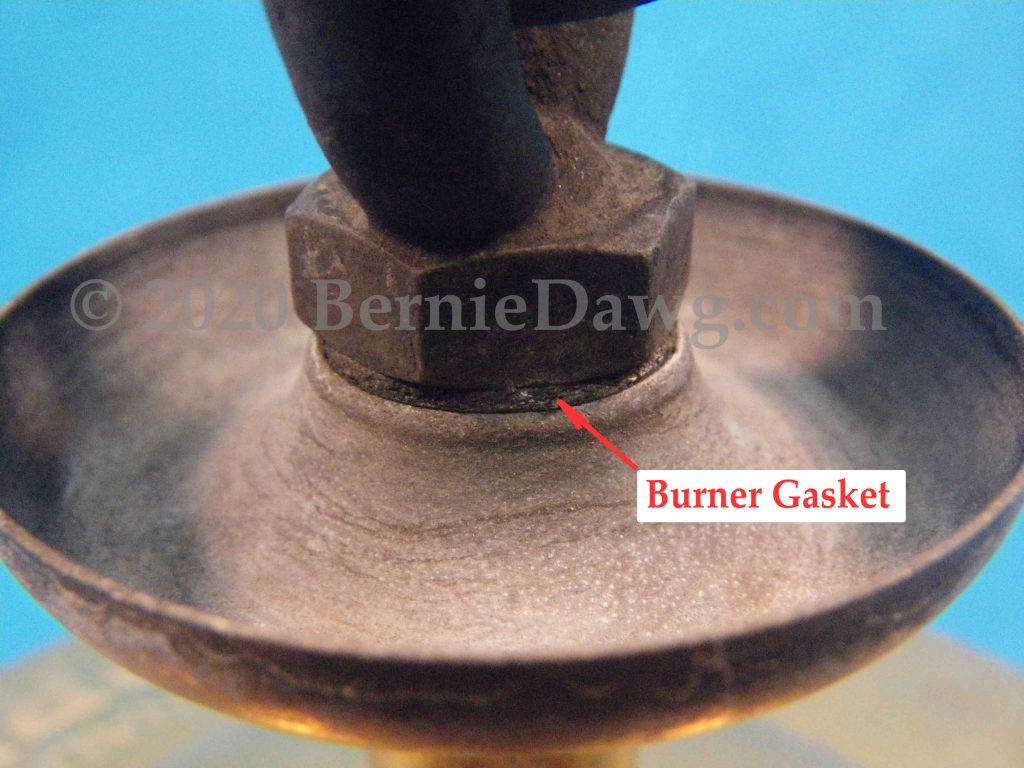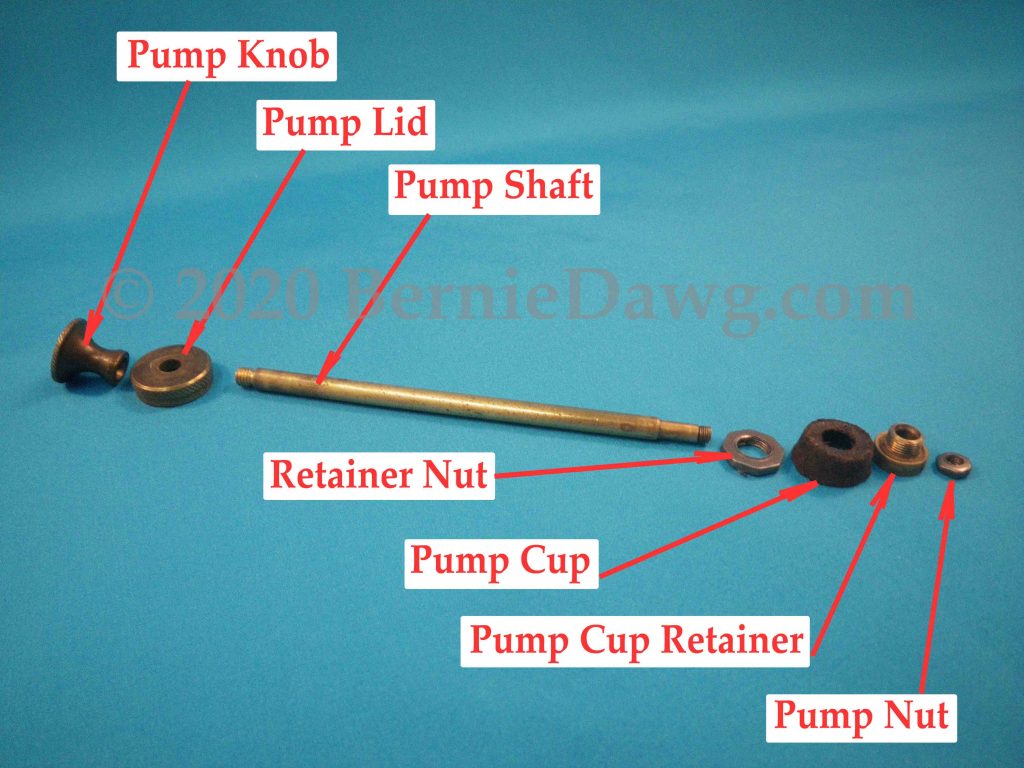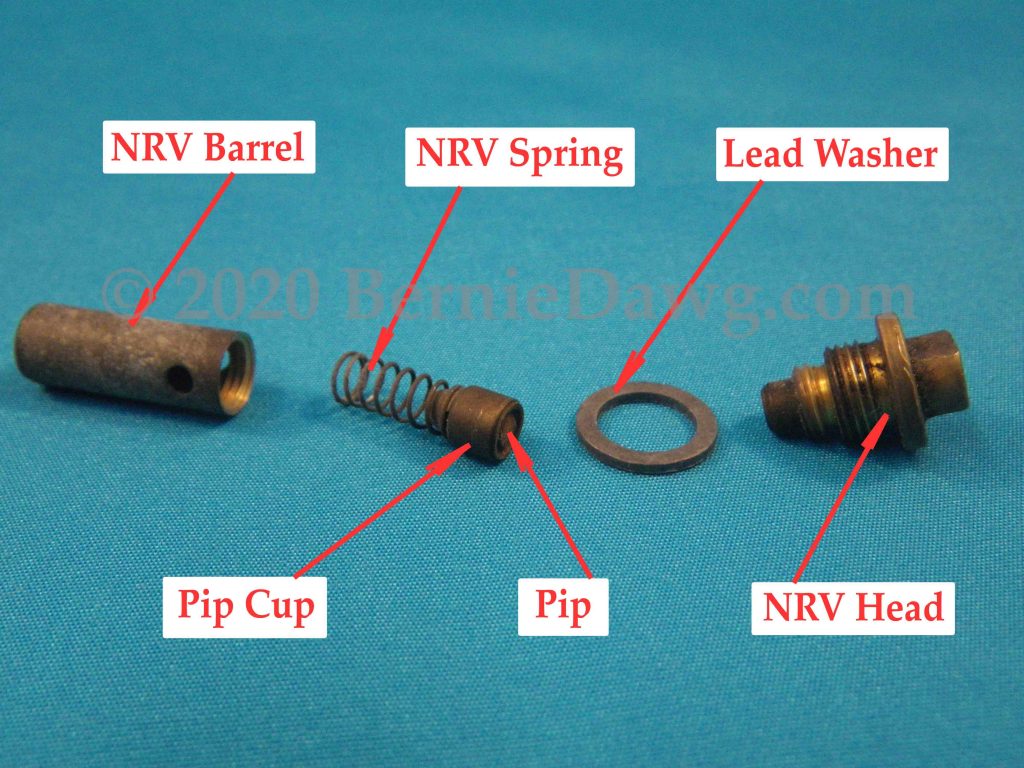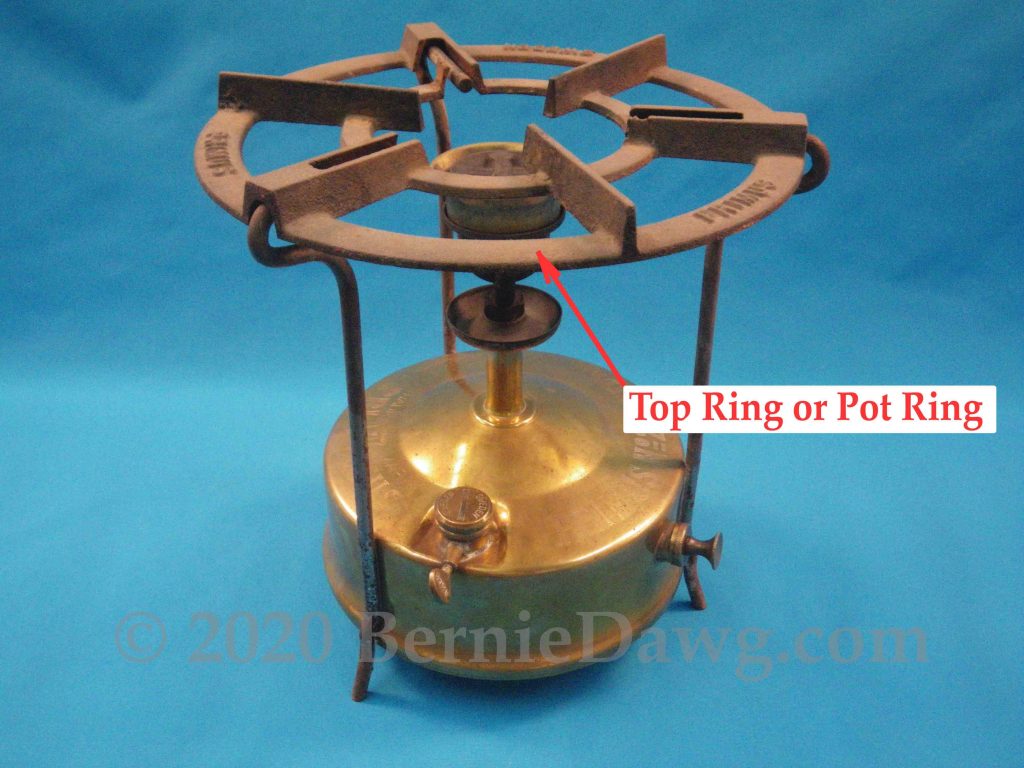The card found in many small tin boxes containing the Primus 96 kerosene-fueled stove. Click the image for a larger version.
Jpegs:
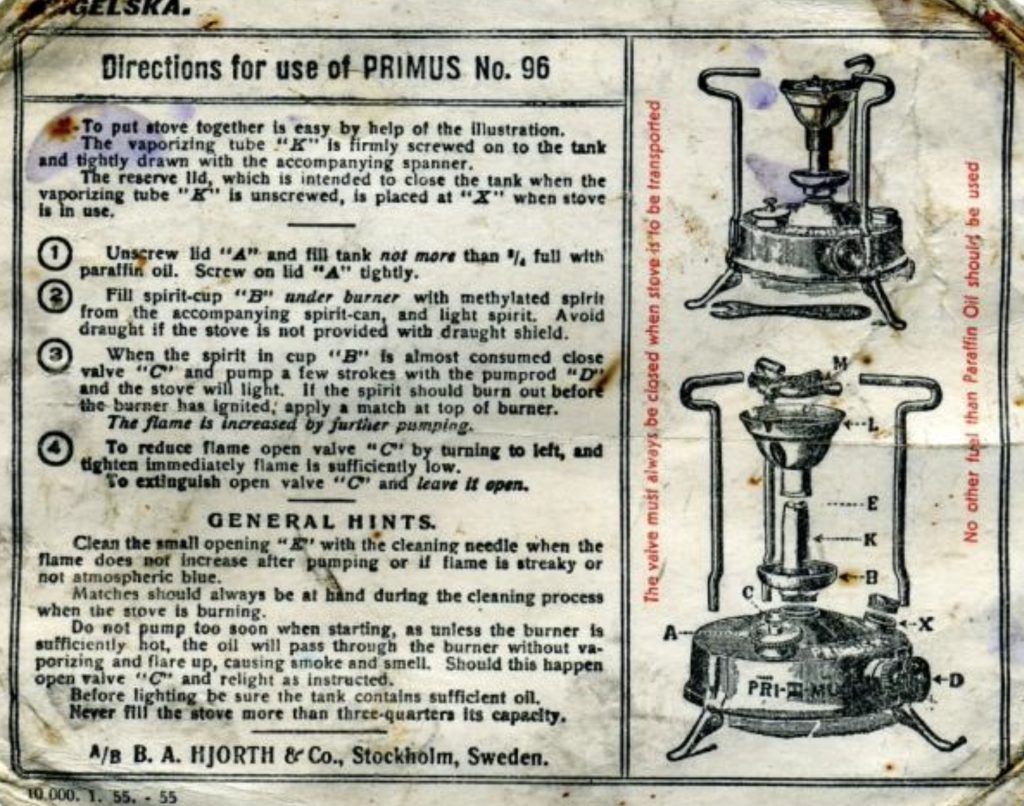
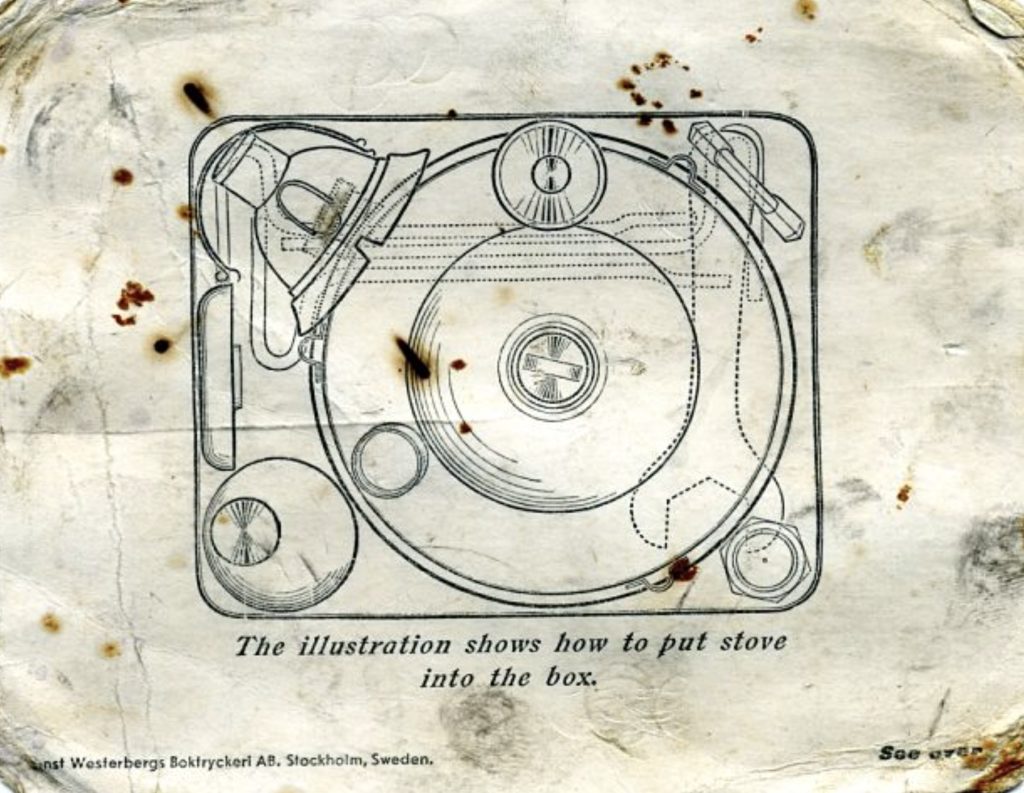
Category Archives: Stoves
Svea 123 or 123R Spindle Key Uses
The Swedish-made Svea 123R is a great stove. The “R” means it has a built-in cleaning needle. The spindle key that comes with the vintage stoves has several cut-outs in the key. The purpose of the cut-outs is to lighten the spindle key, to allow the key to dissipate heat and to serve as useful tools for the stove in the field. Here is a quick explanation of the functions of the tool cutouts in the spindle key.
The predecessor of the Svea 123R is the Svea 123 (it has no “R” in the stove name.) The spindle key that was bundled with Svea 123R stoves also had cutouts for this earlier version, the Svea 123. The keys were used interchangeably during the years that both types of stoves were co-produced.
The spindle nut is smaller on the Svea 123, and the opening in the photo below is used to tighten or loosen the spindle nut. Usually used to tighten the nut as the graphite packing in the spindle wears with use.
The cheaply made and low quality Optimus Svea 123R stoves now coming out of Taiwan still feature a spindle key that includes the opening for the Svea 123 spindle nut even though the Taiwanese never made that stove and that stove stopped being produced in Sweden pre-1970.
Some people, new to these sorts of stoves, or with little background on these stoves, will claim that the Taiwan stoves are of equal quality. But, sadly, those people have never had a genuine Swedish-made Svea in their hands. It is fairly well documented on social discussion forums about stoves that the Taiwanese Svea 123R stoves are of lesser fit and finish than the original Swedish made stoves. There have been quite a few reports about failures to positively shut-off straight out of the box. In my own work repairing stoves I have had a half dozen brand new Taiwanese Svea 123Rs sent to me in just the last year for failures to positively shut-off. The spindle seats are often poorly formed and the brand new stoves will leak right out of the box. If you are considering the purchase of a Svea 123R, PLEASE buy a used vintage one. There are lots of them around and they are much better made than the poor quality Taiwan stoves.
Primus Stove, Lantern and Appliance Dating Chart
Primus paraffin stoves, lanterns and blow lamps (blowtorches) are stamped with a letter code starting in 1911. The letter code can be found on the bottom of the tanks of these liquid fuel pressure appliances. The letters Q and AQ are not used in the coding system. Starting in 1955, the code method changed and a six-digit code was used. The last two digits of the six-digit code correspond to the year of production. The six-digit code can often be found on the leg of the stove or on the burner riser of the stove. Toward the end of the last years of Primus production, the code was no longer stamped on the stove but was found on the carton the stove shipped in.
There is often an additional number or letter stamped on the tank. It is unclear what this was for, but it is possible it was a production line identifier, or lot batch number.
Primus is the only liquid-fueled pressure appliance company of which I am aware that dated their offerings with a date code. Other manufacturers appliances must be dated by examining the features of the appliance and comparing them to catalog drawings, photos, illustrations and known dated appliances of the type.
You are welcome to freely copy and distribute this dating chart, link to the dating chart, or link to this webpage. Click on the chart or the photos below for larger and higher resolution images. While I made this chart from scratch, I am not the originator of the chart. For the record, I only published my homemade chart here after I saw that the original chart (found on a popular and well-known social discussion forum requiring a membership and/or subscription fee) has been published in full resolution far and wide all over Pinterest. So, the horse has already escaped the barn. I do not believe knowledge should be held ransom behind a subscription fee. Apparently a lot of Pinterest users agree, and you should agree, too. 👍
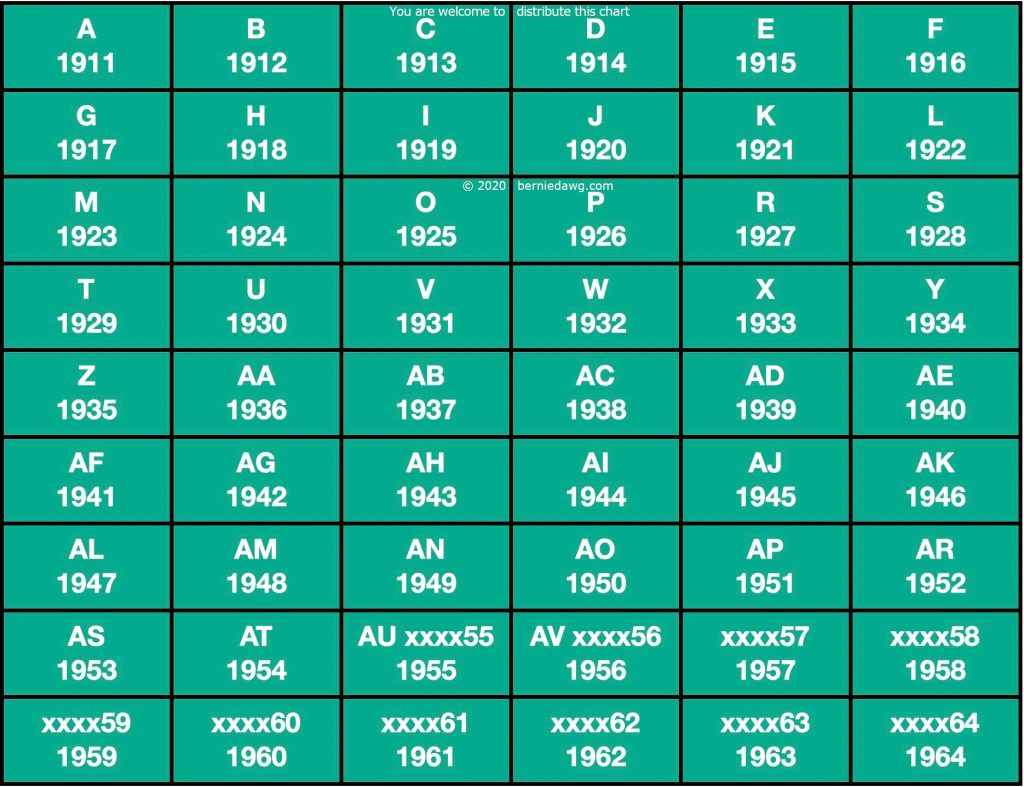
Here are some examples:
Optimus 111T Stove Manual and Instructions
Here’s a repost of the Optimus 111T Stove Manual and Instructions. This stand-alone post should make it easier for folks to find this document.
Click the link below to download a PDF with big image and good quality.
Optimus 111T Manual
Or, just use the JPGS below. Feel free to distribute far and wide and download onto your device. Knowledge should be free!
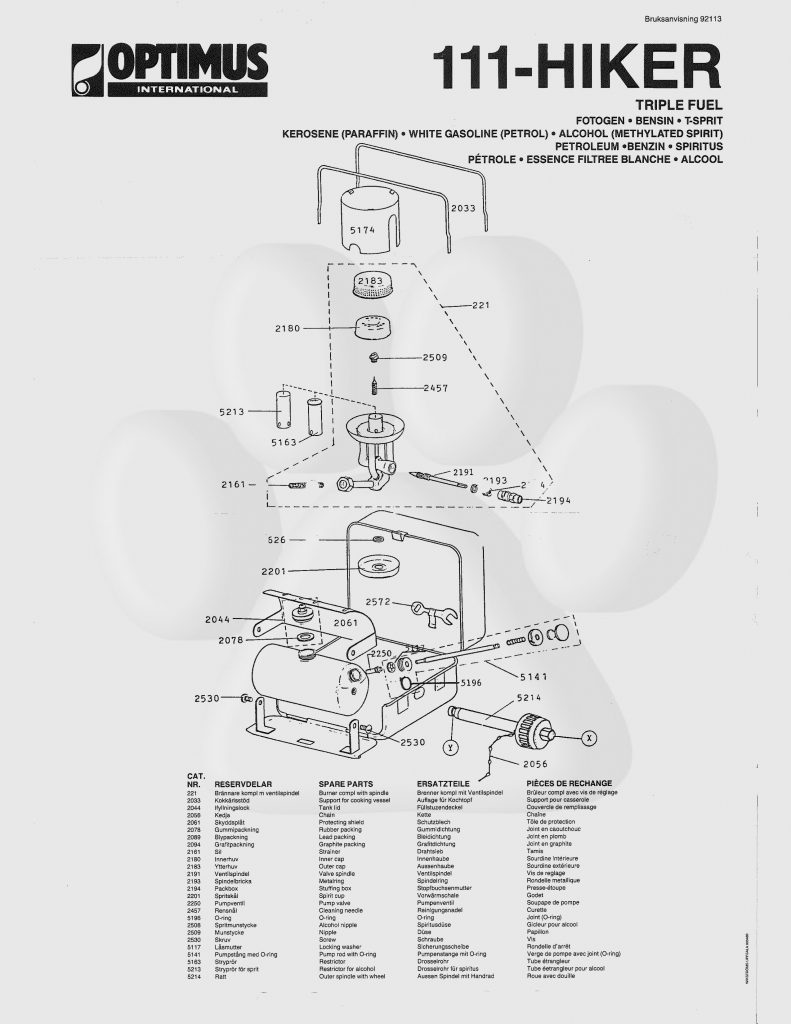
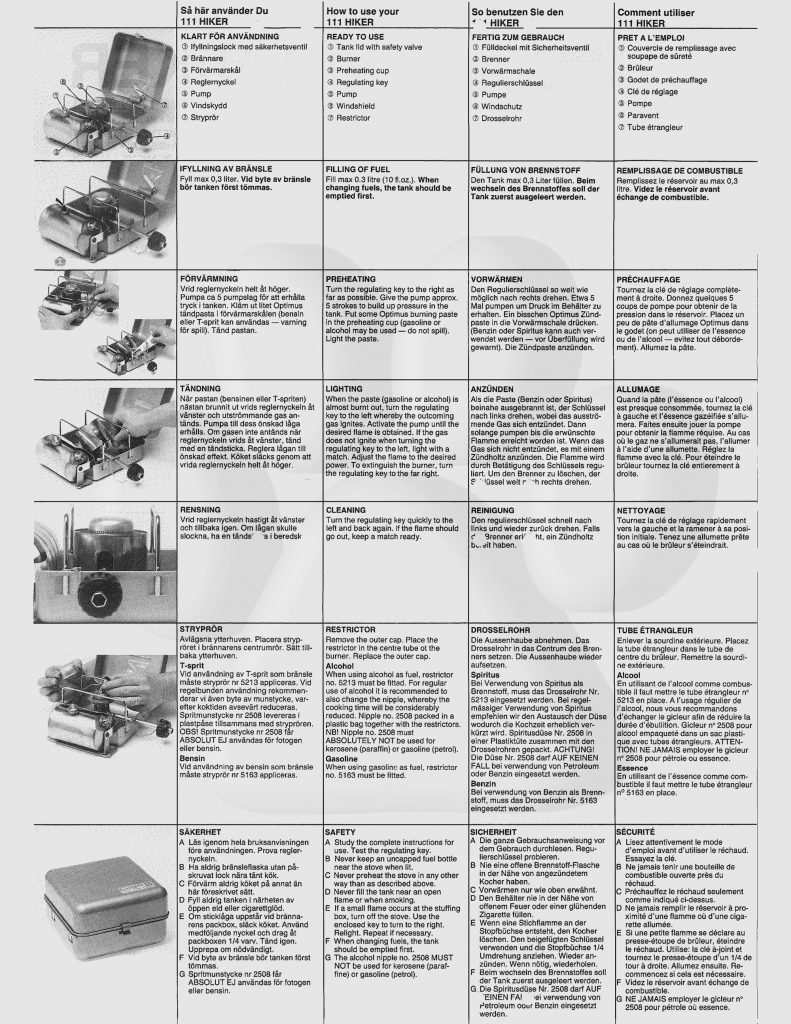
Optimus 111B Instruction Manual and Parts List
Optimus 8R Manual
PDF copy for better resolution: Manual_Optimus_8R
Svea 123R Manual
For those stove fans who have a new-to-you Svea 123R, here’s the manual in jpg and pdf format.
jpg: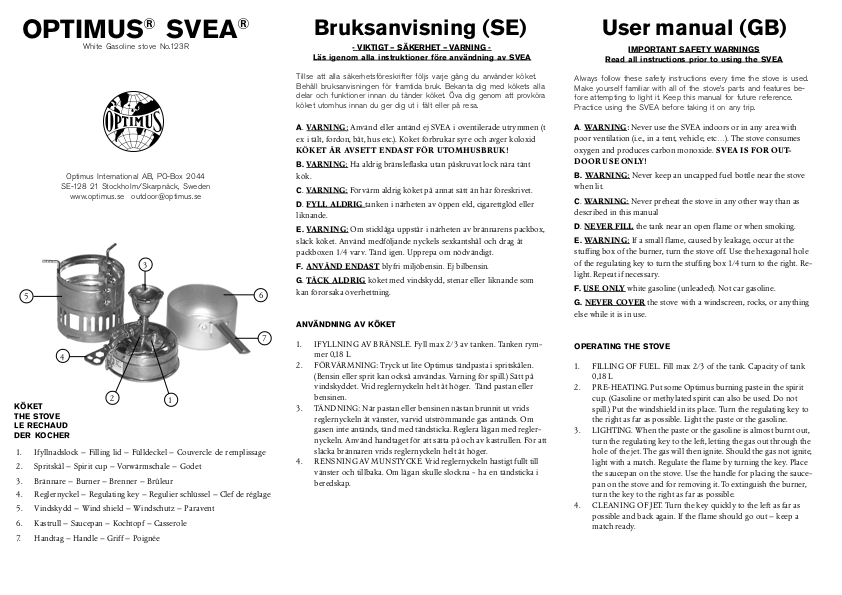
pdf for download (much better quality and sizable/zoomable). Just click on the link and it should come up on your browser.:
optimus_123R_manual
Stove Part Nomenclature (aka Names)
Stove Thread Specifications
For quite some time I’ve been machining adapters and reproduction parts for vintage stoves. I’ve been doing this on much of my client work as needed. I’ve always taken the if-it-could-be-done-before-it-can-be-done-again approach. As I’m getting a bit older, I thought now would be a good time to start recording some of the measured and *proven* threads or thread approximates I’ve come up with that will work well on vintage stoves.
But… first an important fact to understand. The various companies that made stoves (Optimus, Primus, Radius, even Coleman, etc) DID NOT necessarily conform to established “thread standards” for much of their work. This is especially true of the early standards established by Primus at the end of the 19th century (1890’s). Standardized threads would include the metric system, the British system or the American system. Some of these threads may appear on some stoves. But, for the most part, the threads used on vintage stoves are in-house creations of the production staff at the various firms and DID NOT conform to established standards.
Since Primus was the first to get stoves out there, and because they established a wide-spread international network of stove sellers and stove part houses (think todays franchises for fast food), other manufacturers were pretty much required to adapt their thread forms so that they could sell various parts that would mate with Primus stoves. Doing so meant that a Radius burner would fit perfectly on a Primus stove riser, for example.
So, yeah. I *know* that Sweden adopted the metric system in blah-blah year. Doesn’t matter. Stove threads pretty much ignore thread standards, and, that’s what makes stoving both fun and frustrating.
If you are a hobby machinist, you could make a bundle of money making up stove accessories and adapters for some of these old stoves. Sell them on eBay! I sincerely encourage you to do so. You’d be surprised what stove collectors will pay for a bit of brass properly threaded with compatible threads for their stove.
So, here’s the start of the list. I’ll add to it as I find time and energy. I have notebooks full of thread data. Check back whenever you like or if you need data for your stove restoration project.
NRV Threads
The head of most NRVs (non-return valve) found in kerosene-fueled stoves is threaded M8x0.75. The barrel of the NRV is threaded M6x0.75. These are non-standard metric sizes.
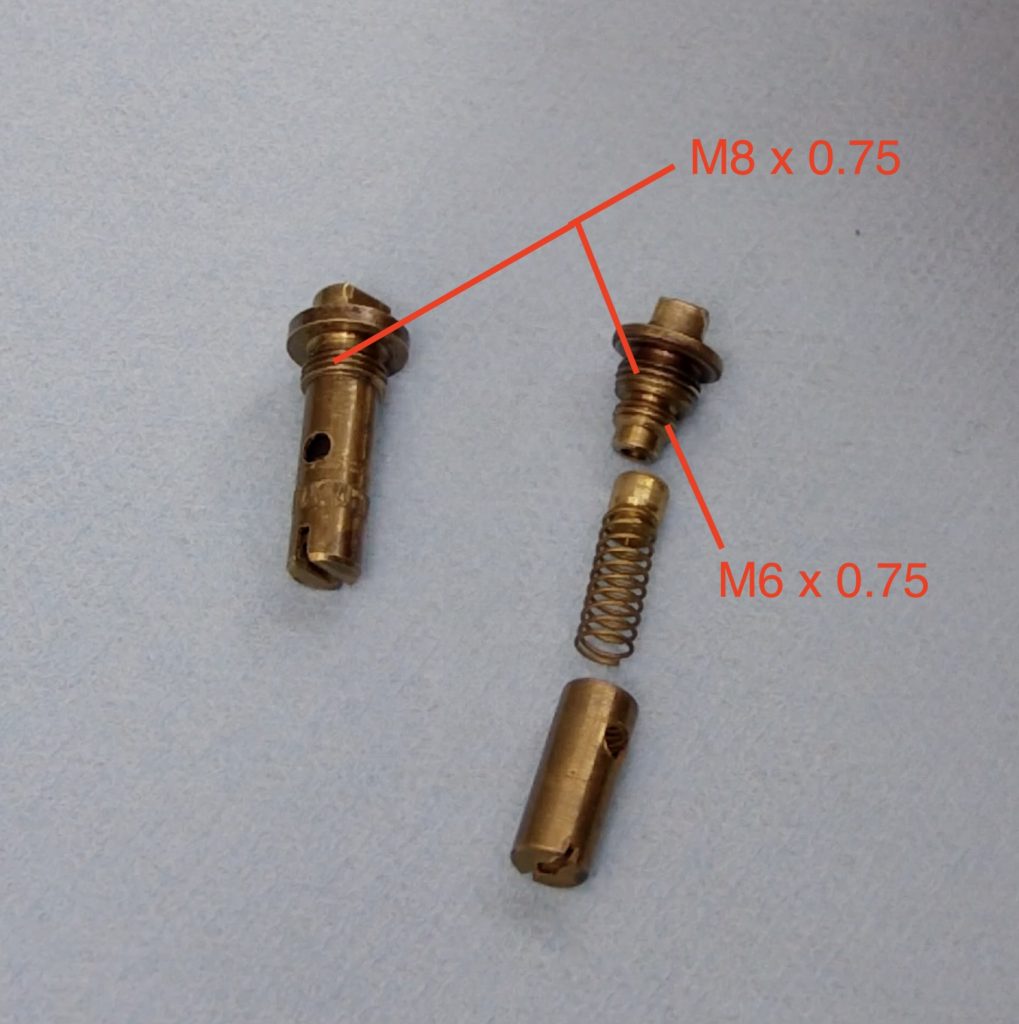
Stay tuned for more as I find time. BD
Repairing An Optimus 111B
Earlier this Fall season I posted a three-part video series on repairing the Optimus 111B at my YouTube stove channel. The videos cover all the steps you need to take to refurbish a vintage 111B stove back to full operation. There are tons of tricks and tips, and practical knowhow included in these videos which will help you working with the 111B, other members of the 111 family, and stove work in general. The videos are free to watch and require no admission or registration fees to watch them.
Check ’em out!
Here are the links to the 111B series:
Optimus 111B Stove Repair Part 1 – Disassembly
https://youtu.be/L-A9IAcaVhA
Optimus 111B Stove Repair Part 2 – Parts Reassembly
https://youtu.be/b-d_YVVuLaA
Optimus 111B Stove Repair Part 3 – Final Assembly and Testing
https://youtu.be/sGo62unFInk
OR… watch them imbedded right here, right now. You can see a lot more detail if you watch full screen.
These are copyrighted videos and are found exclusively here at my stove blog and at my YouTube stove channel. https://www.youtube.com/channel/UC-HRgttvZQQtg7_G0_T6Sqw/
If you see these videos at some other website, they have been stolen and the website moderators/owners are thieves and are in violation of copyright law. Please let me know if you see someone ripping off my hard work for their own benefit – those people who do that sort of stuff are the lowest form of self-serving scum. (Not to be too harsh, or anything.) 😉 Report scumbag thieves to: berniedawgstove@comcast.net
Thanks! BD

